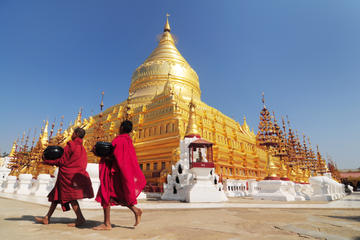Mandalay
TIME : 2016/2/22 12:06:08

Mandalay
Mandalay – the name alone makes a trip to the city seem inviting and evokes memories of ancient Burma. Mandalay has since evolved into the second largest city in Myanmar, but still looks more like a village. There are no skyscrapers pushing up towards the sky, many roads are unpaved and the air is dry and dusty. The river Ayeyarwady is the lifeline of the country and down by the riverfront, houseboats and barges glide past women in colorful turbans sitting on bamboo rafts washing the laundry. The river borders the city in the west, while in the east, Mandalay is limited by Mandalay Hill, the mound that gave the city its name. Apart from the hill, one of the biggest attractions is Mandalay Palace, which is surrounded by an iconic wall and moat and today houses the military barracks.
Right before the British colonization, Mandalay, then still called the Golden City, was the capital of the Burmese Kingdom. But the Second World War hasn’t left much of the old magic of Mandalay intact, most of the pagodas and palaces were destroyed and the traditional teak wood houses have disappeared. Now, Mandalay is a city of crafts and many of the families have specialized in creating the gossamer gold leaves, which get glued on to pagodas, stupas and statues around to country by the many Buddhist believers. Washing the metal from the floods of the Ayeyarwady River and hammering the pieces in to leaves so thin, that they float on the air, in a way, makes the old name Golden City true again.
Practical Info
Mandalay is located in the center of Myanmar on the Ayeyarwady River. Mandalay International Airport, located about 45 kilometers outside of the city, offers flights to several other Asian destinations, such as Kunming, Bangkok and Chiang Mai. There are numerous daily 9-hour bus and 15-hour train connections from Yangon, although the bus is by far the more comfortable option. An interesting alternative is a 10-hour ferry ride from Bagan.
